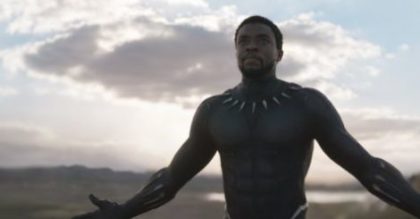
Last week’s post on Avengers: Infinity War generated interest in a follow-up, so we’re returning to the Marvel universe. Again, I’ve avoided spoilers, but I’ll understand if you want to play it safe and wait until you’ve seen the film.
It’s perhaps a strange thing to say about a 2 hour 40 minute movie so full of stars it threatens to collapse into a black hole, but I feel Avengers: Infinity War was missing something. Both earlier Avengers films made time to consider the plight of folks who don’t have alliterative names or the narrative security of an already announced sequel. We saw our heroes protecting and rescuing innocent bystanders, like the office workers for whom Captain America took a grenade or the family Iron Man carried to safety in a bath tub. We also met Beth the waitress (played by Ashley Johnson) in The Avengers and Zrinka the concerned older sister (played by Dominique Provost-Chalkley) in Avengers: Age of Ultron. Each got multiple, albeit brief, moments before, during and after the respective third act battles, allowing the audience to develop a personal, emotional connection to the global stakes.
Avengers: Infinity War has little time for such humanism; it is too busy humanizing its motion-captured antagonist. While we get an explicit accounting of the cost if Thanos succeeds, it’s an abstraction of statistics. Crucially, we don’t see any of the Avengers intervening on behalf of civilians. They do express genuine fraternal concern and demonstrate sacrificial love; we are never given reason to suspect our heroes seek personal glory or power. At the same time, we don’t get much hint of a motivation outside of their social network.
Over the weekend, Tom posted a question about the Good Samaritan and how the story has been depicted artistically. At their best, I think superhero stories can reflect the essence of Jesus’ parable. In times of crisis, the Avengers look outward to see the needs of others and use their resources to meet them as best as possible. Sometimes they use strength or speed or lasers to stop a physical threat. Sometimes they use wealth and influence to stimulate community development, as in Black Panther. They are problem-solvers, and their sense of which problems need to be solved extends outside themselves to problems that affect others primarily or exclusively.
Black Panther, which preceded Avengers: Infinity War by a few months, may have been the best superhero cinema meditation on the question of who my neighbor is. T’Challa, king of fictional African nation Wakanda and champion of its patron panther god, enjoys a certain freedom by virtue of his station. It is freedom from the burden of knowledge: knowledge of his heritage and of the cost it imposed on his people. Indeed, he does not even appreciate the full scope of who his people are. As T’Challa confronts the responsibilities revealed to him, I found it hard not to wonder what luxuries of ignorance I enjoy–a luxury seemingly more desirable in the age of information. I was struck by that question again reading this Atlantic piece by Ta-Nehisi Coates (note: some coarse language), who incidentally also writes the Black Panther comic series and will soon be writing a must-see run on Captain America.
If not knowing is a form of freedom, how can it be that the truth will set us free, as Jesus promises in John 8:32? Rather than a freedom from knowledge, the truth is a freedom to act. Like the Good Samaritan, we can only help our neighbor when we first learn the truth of their need. And the truth also sets us free from the world as it is, by revealing the world as it could be. Therein lies what makes the news of the Gospel good. “But God demonstrates his own love for us, in that while we were still sinners, Christ died for us.” (Romans 5:8) God saw the truth of our sin and our inability to free ourselves from it. He acted generously and decisively to reveal a deeper truth, that a life without sin and death is possible.
Andy has worn many hats in his life. He knows this is a dreadfully clichéd notion, but since it is also literally true he uses it anyway. Among his current metaphorical hats: husband of one wife, father of two teenagers, reader of science fiction and science fact, enthusiast of contemporary symphonic music, and chief science officer. Previous metaphorical hats include: comp bio postdoc, molecular biology grad student, InterVarsity chapter president (that one came with a literal hat), music store clerk, house painter, and mosquito trapper. Among his more unique literal hats: British bobby, captain’s hats (of varying levels of authenticity) of several specific vessels, a deerstalker from 221B Baker St, and a railroad engineer’s cap. His monthly Science in Review is drawn from his weekly Science Corner posts — Wednesdays, 8am (Eastern) on the Emerging Scholars Network Blog. His book Faith across the Multiverse is available from Hendrickson.

Leave a Reply